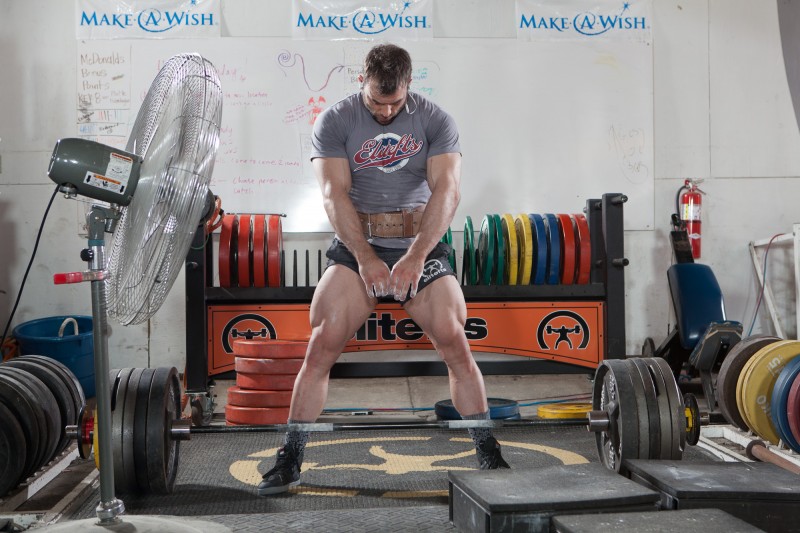
Way back when I first started training, I spent a lot of time daydreaming (this was back in high school). I’d take the dog out for a walk through the neighborhood and imagine how great it would be if only I could squat 500, bench 400, and pull 600. Hey, give me a break — at the time, I was benching about 95, so I was definitely dreaming big.
A few years later, I started getting a little more focused with my dreaming. The night before a heavy workout, I’d think through every rep and every set. I’d imagine myself smashing out rep after rep, set after set. I’d get so hyped up that I wouldn’t be able to sleep that night, and then the next day, end up dragging my ass through a training session about half as intense as I’d hoped.
Lots of athletes use visualization techniques like these to help them perform better in sport, but if it’s not practiced pretty carefully, visualization oftentimes falls pretty flat. Don’t get me wrong: it can be enormously helpful in learning to perform at your best – if you go about it in the right way.
How To Practice Visualization
Think of visualization as a sort of mental rehearsal. In academic circles, it’s usually referred to as imagery: a mental experience of an event that mimics an actual experience, and which can have both psychological and physiological consequences for an individual.
When most people think of visualization, they think of something pretty darn similar to daydreaming: imagining a future performance, something in-between a guided tour through La-La Land and directed positive thinking. (That’s actually a pretty apt description of my high school walks.) In truth, there’s no “right” way to visualize, but there are two key ingredients:
- You need to create, or imagine, the future event in your mind.
- You need to practice.
Yeah, sorry to burst your bubble, but there’s really no such thing as 60 seconds to a huge PR. Training, whether it’s mental or physical, requires practice.
So those two things are the basics, but we can get more complicated with it. First, effective imagery is usually vivid: it’s more than just “seeing” an event in your mind. As you visualize a heavy deadlift workout, for example, you might recall the roughness of the bar’s knurling against your palms, the scent of talcum powder, and the sounds of clanging barbells and Pantera. This is called a multisensory approach.
You’re not limited to your senses, though. In fact, when I practice visualization, or help my athletes visualize, I prefer to focus on the emotional quality of a performance. Instead of the tangible aspects on an event, I recreate the feeling right before a heavy lift, which, for me, is somewhat euphoric (a lightness in my stomach and head, and a sense of energy). As I’ll explain later, this type of approach can help to avoid some of the drawbacks of typical visualization.
Finally, there’s the element of perspective. When you visualize, you can choose to “watch” yourself perform, as if in the third person; or you can experience the performance, as you would if you were actually doing it. There’s no right or wrong here, and in fact, many athletes use both approaches.
Once you’ve built a visualization routine, you need to practice it. Daydreaming once in a while isn’t enough, especially if you’ve got a big meet or even just a big workout coming up. Instead, set aside some time – maybe as part of your daily meditation practice – to mentally rehearse an upcoming performance. You don’t need to spend a long time doing this. Five or ten minutes a day is plenty.
The Pros and Cons of Visualization
Visualization (especially the multisensory variation) has some well-documented benefits for sports performance. While research hasn’t definitively proven how visualization works, most studies agree that it does:
- Improve self-confidence. By mentally rehearsing the minute details of an event, athletes become more confident in their ability to perform in that event – and, unsurprisingly, more confidence usually leads to a better performance. Detail and repetition are important here, as they reinforce the athlete’s belief in future success. If you’re having trouble hitting depth in your squat because you start to get nervous when you hit the hole, visualizing hitting perfect depth over and over again can help you to actually do it.
- Reinforce movement patterns. Even though visualization doesn’t actually involve movement, some researchers theorize that the process of visualization evokes a psychoneuromuscular response similar to that produced by movement. In other words: while it isn’t quite as good as practice, visualization still has many of the same benefits as practice. (This is where we get the urban legend of the prisoner of war who played an imaginary round of golf in his mind each day of his captivity found upon his release that he’d markedly improved his game.)
- Increase psychological arousal. Along the same lines, visualizing a performance can help recreate many of the same physical feelings experienced in the actual performance. So, if you need to get amped up in the gym, imagining that you’re actually stepping out onto the platform to take your third deadlift might give you the shot of adrenaline that you need to smash some big weights.
It’s not all good, though. Visualization, even when carefully directed, can also have negative impacts on performance. The most common negative impact involves expectations. Let’s say you’ve been visualizing a 9/9 meet. You’ve played it over and over in your head: nailing every attempt, smashing PRs left and right, even celebrating afterward. Then you get to the meet and you miss your squat opener. What happens? Many people panic in this situation. Suddenly, all of their plans are ruined, because one thing went wrong, and they had only planned for a perfect day.
Obviously, you don’t want to end up in that situation. So instead of visualizing a perfect day, or even visualizing a really good performance, try visualizing how you will respond to the inevitable adversity. Nobody ever has perfect days. Something is bound to go wrong, and even if it’s a little thing, being prepared will help you to stay cool, calm and collected when the pressure is on.
When to Use Visualization in Your Training
Personally, I don’t use visualization all that often. I used to and found that I tended to just psyche myself out, and I’ve since developed other mental strategies for my day-to-day training. I still do practice visualization, though, and I think it’s particularly helpful during these times:
- When you’re practicing technique.This is my favorite, and again, a lot of research suggests that visualization is effective at reinforcing movement patterns. When you’re learning a new technique, or unlearning a bad habit, visualization can help you to get a benefit similar to that of cranking out a few additional reps without any actual strain on your body. While it’s tempting to do this before training, or maybe on an off day, I find that it’s actually most effective immediately after or even during training. If you’re really trying to keep your back flat on heavy deadlifts, and you hit a rep that feels perfect, take the time between sets to sit down, close your eyes, and replay that rep in your head a few times. That reinforcement will go a long way towards making the next rep perfect, too.
- When you’re preparing for a meet.This one seems obvious, but it’s worth mentioning for that very reason. On meet day, there will be so much going on that you won’t have any time to think about your upcoming performances (and you shouldn’t try to do so). Visualizing the day ahead of time can help you to be prepared and respond calmly no matter what happens.
- When your training is going poorly.We all get into ruts now and then, and they can be really frustrating. Note that I’m not talking here about plateaus: if your bench has been stuck at 395 for the past two years, then you probably need more than just mental rehearsal to get it moving again. But if you’ve just had a couple of subpar sessions and are feeling out of the groove, visualization can help you get your mojo back. Remember: don’t try to visualize the perfect day (although that can be helpful, sometimes, if you just need a mental boost and not a physical one). Instead, rehearse how you’ll respond when the weights feel pretty heavy.
- When your training is going really well. On the other hand, if you’re at a high point in your training cycle, visualization can help keep that going longer. It’s the same principle as we used with technique: if you have a great session, immediately replaying it in your head can help to make the next one great, too.
Obviously, you don’t need to restrict your visualization to these times, but if you’re looking for a place to get started, you won’t go wrong with the above.
The Role of the Coach in a Visualization Practice
There’s plenty of things wrong with online coaching right now, but I think one of the biggest is the almost complete lack of attention paid to mental training. Your athletes aren’t just bodies, they’re people, and their brains play an enormous role in their overall success. It’s obvious when you have an athlete who’s feeling down about a bad workout or stress outside of their training: subsequent performance tends to be mediocre. On the other hand, athletes who are really fired up consistently outperform expectations. So why the hell aren’t you helping them stay in that winning mindset as much as possible?
When it comes to visualization, coaching is admittedly tricky, because (as explained above) everyone does it a little bit differently, and that’s okay. As a coach, your job is to facilitate the process, not direct it entirely. For example, let’s say you’re teaching someone a basic movement pattern, like a hip hinge. Compare the following statements:
- “Chest up, shoulders down, glutes tight. Now brace hard and sit back.”
- “Push your chest up nice and high, like you would if you were walking down the beach with your shirt off. Now squeeze your abs hard, pulling your hips under you, just like in a leg raise. Got all that? Okay, now imagine I’ve got a string tied to your tailbone and I’m pulling it back, but you’re keeping that nice high chest and tight abs. How does that feel?”
Obviously, the second is a much more vivid description, and after a session (which obviously needs to include physical drills, not just verbal cueing) an athlete can go home and visualize the motion much more effectively because of it.
You shouldn’t limit this type of “coached imagery” to training. Take a situation where you’ve got a nervous athlete preparing for his first powerlifting meet. What’s going to be more helpful: telling him, “yeah, there’s gonna be a lot of people there, you’ll probably feel pretty nervous, so be ready?” Or describing what it feels like to walk into the meet venue, to find a spot in the warmup room, and to step out onto the platform for the first time?
One final note on coaching: don’t force mental strategies on an athlete who’s not responding to them. This seems obvious, but for some reason, the intangibility of mental training often makes it seem less impactful than physical training. That’s not the case, and you should treat the two with equal care.
If You See It, You Can Achieve It
I’m not one to rely on inspirational speeches or motivational quotes, but this one seems appropriate for an article about visualization. Mental rehearsal alone isn’t going to make or break your training; you’re not going to turn into a Buddhist monk and magically bench 100 pounds over your max because you imagined it. But when used carefully and as part of an otherwise sound physical and mental training program, it can be an extremely helpful tool in your kit.
After my last article, someone asked me to share some personal experiences with mental training in my powerlifting career, so I’ll end with this: leading up to the US Open last year, I was dealing with some personal issues. They had nothing to do with training, but they added a lot of stress to my daily life. So my workouts took on some added importance — they weren’t just meet prep, they were also my source of stress relief. I’m sure a lot of you can relate to that.
Well, the thing is, for me, meet prep is extraordinarily stressful. I tend to obsess over every little thing that might go wrong: I might get injured, or miss weight (yeah, right) or have a nervous breakdown because I’m worried about missing weight (more likely). So using it as a source of stress relief was pretty tricky. Visualization helped enormously.
I did two things: first, I visualized how I would respond to adversity, not how I would perform at my best. I mentally rehearsed missing my opening squat (something I’ve done several times) and coming back to nail a big third attempt (again, something I’ve done several times). I rehearsed tweaking a pec on bench and finding the confidence to stay in the meet for deadlifts, anyway. I even rehearsed missing weight and lifting with the heavies.
Second, I visualized the emotions I felt after winning my last big meet (Boss of Bosses 3). That prep was, and still is, the most stressful I’ve ever had, and it actually led directly to the personal problems I was dealing with before the Open. It was also my first big win on an international stage. So the feelings afterward were pretty damn strong, and I actually I teared up a little bit. Even now, typing this, I can still feel some pretty powerful physical feelings from that moment, and those really help me to keep my head in the game.
I ended up having a literally perfect day at the Open, all the way up until my final deadlift attempt. Every single moment between arriving at the meet venue and stepping onto the platform for the last time went according to plan, and I have no doubt that that was as much a result of my mental preparation as my physical training. Your visualization practice doesn’t have to be anything like mine. But if you develop one and use it consistently, I’ll bet you see pretty similar results.












1 Comment